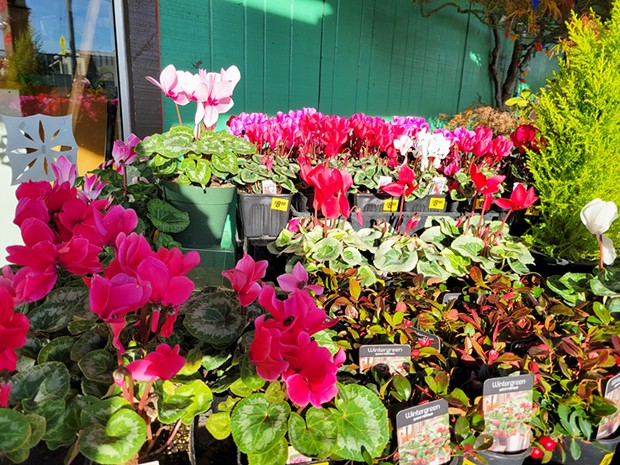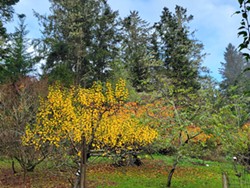[
{
"name": "Top Stories Video Pair",
"insertPoint": "7",
"component": "17087298",
"parentWrapperClass": "fdn-ads-inline-content-block",
"requiredCountToDisplay": "1"
}
]
Now that a real rainy season has returned to Humboldt County, it's time to think about the new gardening year.
Winter is nearly here, and while the days can be gray and dreary, there's still plenty of color to admire in the landscape. As I drive around town, I notice the trees that still have their beautiful fall foliage, such as maples (Japanese, big-leaf maple and vine maple, to name a few), golden ninebark, flowering cherry, blueberries and apple trees have all caught my eye. Sure, it's not Minnesota or New England, but there's still plenty of eye-catching foliage to be appreciated right here in Northern California. This is a good time to think about planting one of these trees or shrubs in your landscape for future fall color. Check with your local nursery for stock.
In addition to trees that offer color in the winter, think about adding some seasonal color in the form of flowers and flowering shrubs. Primrose, pineapple sage, cyclamen and Mexican mint marigold (a shrub I only recently got to know after brushing up against one in a client's yard) all have showy flowers right now.
Thinking about future fruit in your garden? Bare-root season is nearly upon us. Most local nurseries get their bare-root stock starting in late December, going through January and February. Everything from Chandler blueberries to Cox pippin apple trees can be had at a discount when it's bare-root time. Just make sure you heel those in after you buy them — that means putting the roots in a place where they won't dry out, but not in the final planting spot. Raised beds or a pot with a good quality soil are good spots to heel things in until we have a few dry days. To avoid compaction of the soil, make sure you wait at least three to four days after a good soaking before you plant, otherwise, the roots don't get a chance to breathe. I foolishly didn't follow my own advice last year and planted a couple blueberry plants a day after a good rainstorm. They died. Don't be like me. Wait for the soil to dry out.
Winter is a good time to get your garden tools sharpened. There are a gazillion videos online showing the proper way to sharpen not only your pruners, but your shovels, spades and loppers. Sharp tools make for cleaner cuts when pruning, which helps prevent disease. And speaking of pruning ....
After fruit trees have lost their leaves, it's time to think about pruning them. Please note I said prune, not chainsaw and amputate. Apple trees, for example, grow fruit on wood that's 2 or more years old, so if you hack off an entire branch, don't be surprised if you get exactly zero fruit the following year. There are plenty of good books out there that elaborate on pruning techniques, but if you aren't interested or able, you can always hire a professional. It's been my experience that some of the lawn services say they offer pruning but hack the snot out of trees. Not all, of course. But I cannot emphasize enough that just because someone says they "know how to prune" doesn't mean they actually do. We get called in often to repair hack jobs done by a former homeowner or some lawn care service that went all Edward Scissorhands on an apple tree. It pains gardeners to see amputated trees all over town, trust me.
Other plants that can benefit from pruning at this time of the year are flowering shrubs. The general rule for pruning shrubs is "prune after bloom." Now, given our wild and wacky weather, some shrubs are flowering right now, when their normal flowering time isn't for a few months. Don't prune those. They'll put out a better flush of blooms at their usual bloom time. Some azaleas and rhododendrons are in bloom already, though the majority don't bloom for another month or two. These should be pruned after they're done blooming, or else you'll kill all the flowers for next year's show.
Fall and early winter are also an excellent time to relocate plants in your garden that are in the wrong spot, or ones that are taking over a spot because the height on the plant tag was a lie. Just as for planting, don't transplant things until the soil has dried out a few days after a good rainstorm. It's also a good time to note how the sunlight has changed in your garden or landscape, perhaps due to the neighbor's trees growing taller over the past decade, now shading out your poor little blueberry bushes. Observing where the sunlight is and how many hours of light an area gets throughout the year can help you plan future planting areas.
And finally, during those dark days of winter, what's better than daydreaming about the garden to be next year? I'm talking, of course, about seed catalogs. Soon they'll be showing up in your mailbox, full of plant porn photos, teasing you with pictures that are often rather unrealistic, yet so enticing. If you're not among those whose mailboxes overflow with pretty picture catalogs, you can go online and do a few keyword searches to locate companies that are more than happy to add you to their mailing list. Everything from only tomatoes (only!), to garlic, to a wide variety of flowers and vegetables, there's a catalog (or 13) for everyone.
Finally, don't forget to leave those leaves from deciduous trees on the ground. They'll break down and feed the soil, as well as provide a natural habitat for many creatures, from earthworms to salamanders and butterflies.
Julia Graham-Whitt (she/her) is owner and operator of the landscaping business Two Green Thumbs.
Speaking of...
-
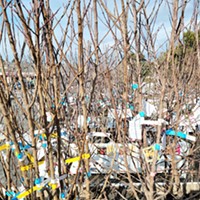
Bare Root Time
Feb 16, 2023 -
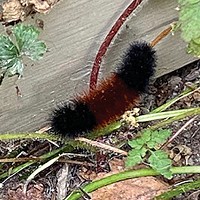
Cleaning Up the Garden
Sep 29, 2022 -
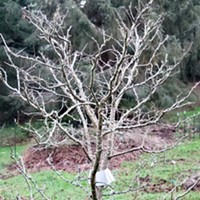
Winter Garden Checklist
Feb 17, 2022 - More »
more from the author
-
Working it Out in the Garden
- Jan 18, 2024
-
Equinoctial To-Do and Native Plants
- Sep 21, 2023
- More »
